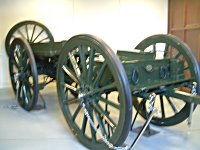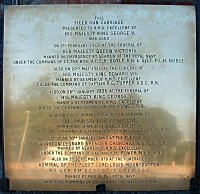Location
In a building close to the entrance of HMS Excellent.

Gun Carriage Plaque

THIS
FIELD GUN CARRIAGE
PRESENTED TO H.M.S. EXCELLENT BY
HIS MAJESTY KING GEORGE V
WAS USED
ON 2ND FEBRUARY 1901 AT THE FUNERAL OF
HER MAJESTY QUEEN VICTORIA
MANNED IN EMERGENCY BY SEAMEN OF THE ROYAL NAVY
UNDER THE COMMAND OF LT. THE HON. A.D.E.H. BOYLE R.N. & S/LT P.L.H. NOBLE
ALSO ON 20TH MAY 1910 AT THE FUNERAL OF
HIS MAJESTY KING EDWARD VII
MANNED BY SEAMEN OF H.M.S. EXCELLENT
UNDER THE COMMAND OF CAPTAIN R.G. TUPPER A.D.C. R.N.
ALSO ON 28TH JANUARY 1936 AT THE FUNERAL OF
HIS MAJESTY KING GEORGE V
MANNED BY SEAMEN OF H.M.S. EXCELLENT
UNDER THE COMMAND OF CAPTAIN A.J. POWER R.N.
ALSO ON 15TH FEBRUARY 1952 AT THE FUNERAL OF
HIS MAJESTY KING GEORGE VI
MANNED BY SEAMEN OF H.M.S. EXCELLENT
UNDER THE COMMAND OF CAPTAIN R.F. ELKINS O.B.E. A.D.C. R.N.
ALSO ON 30TH JANUARY 1965 AT THE FUNERAL OF
SIR WINSTON LEONARD SPENCER CHURCHILL K.G. O.M. C.H.
MANNED BY SEAMEN OF H.M.S. EXCELLENT
UNDER THE COMMAND OF CAPTAIN A.M. POWER M.B.E. R.N.
ALSO ON 5TH SEPTEMBER 1979 AT THE FUNERAL OF
ADMIRAL OF THE FLEET LORD LOUIS MOUNTBATTEN
K.G. G.C.B. O.M. G.C.S.I. G.C.I.E. G.C.V.O. D.S.O.
MANNED BY MEN OF THE ROYAL NAVY
UNDER THE COMMAND OF CAPTAIN R.K.S. BETHELL O.B.E. R.N.
Further Information
The curator of the museum at HMS Excellent, and Keeper of the State Gun-Carriage, Lt. Cdr. Brian Witts tells why the gun-carriage is always pulled by sailors at state funerals.
The origin of the privilege lies in an incident at the funeral of Queen Victoria on February 2, 1901. A Royal Guard from HMS Excellent was drawn-up at Windsor Station under the command of a lieutenant, the Hon Algernon Boyle, the first gunnery officer. It was early February, a cold blustery day with intermittent snow flurries. Everyone from seamen to soldiers lining the streets, to mounted officers, to high officials was cold. Knowing how much their beloved Queen appreciated smart seaman, they refrained from wearing greatcoats. The mounted officers walked their horses around from time to time to stop them getting restive but any gentle exercise for the seamen, like marking time, was denied.
The timing for the funeral procession in London went awry and and when the coffin and cortege finally arrived at Windsor the troops had been in position without moving, for more than 90 minutes. When the order to move off was given the gunners had trouble with their horses and some started to rear. It looked as if the coffin would fall from the gun-carriage. Immediately behind were King Edward VII, the Kaiser, the King of Greece and Prince Louis Battenburg.
The panic among the horses spread to the leaders and the situation became very serious. Prince Louis whispered something to the King who nodded and Lt. Noble was ordered to stand by to pull the gun carriage with the seamen guard. Noble passed the message to Lt Boyle. The horses were led off and the sailors grounded arms and formed fours at the head of the cortege. Improvised drag ropes were brought in and so the great Queen went to her rest.
Postscript
On January 27th 1936 [the day before the funeral of King George V] The Times published a letter from Cecil B. Levita containing further information about the reason the gun carriage is pulled by sailors. It ran:-
"Sir,
In your issue of January 25 [1936] you refer to the historic gun-carriage to be used tomorrow. It is stated: At Queen Victoria's funeral there was an unfortunate contretemps in connection with the horses which were to have been used to draw the coffin up the hill at Windsor, and the blue-jackets [naval ratings] manned the drag ropes in the emergency.
It would, perhaps, be more accurate to say that the contretemps was in connection with the so termed gun-carriage than "with the horses" or their handling by the Royal Horse Artillery.
February 2, 1901, was a bitterly cold day with some snow, and the gun-carriage, under the charge of S Battery, R.H.A., [Royal Horse Artillery] and under the independent command of Lieutenant M. L. Goldie, had been kept waiting at Windsor Station, together with naval and military detachments, etc., for a considerable period. I had posted N/R.H.A. which battery I commanded, in the Long Walk ready to fire a salute of 81 guns, commencing when the cortege left Windsor Station for St. George's Chapel, at about 3 p.m. I placed Lieutenant P. W. Game (now Chief Commissioner of Metropolitan Police) in command, and proceeded to the station to ensure that signalling arrangements were perfect. When the Royal coffin, weighing about 9cwt., had been placed on the carriage, drums began muffled rolls, which reverberated under the station roof, and the cortege started.
Actually, when the horses took the weight, the eyelet hole on the splinter bar, to which the off-wheel trace was hooked, broke. The point of the trace struck the wheeler with some violence inside the hock, and naturally the horse plunged. A very short time would have been required to improvise an attachment to the gun-carriage.
However, when the wheelers were unhooked the naval detachment promptly and gallantly seized drag ropes and started off with the
load. The "gun-carriage" had been specially provided from Woolwich and was fitted with rubber tyres and other gadgets. This was due to Queen Victoria's instructions after seeing a veritable gun-carriage in use at the Duke of Albany's funeral, as also was the prohibition of the use of black horses.
On February 4, in compliance with the command of King Edward, I conveyed the royal coffin, on another carriage, from Windsor to the Royal Mausoleum at Frogmore by means of the same detachment of men and horses. I may add that a few days later King Edward told me that no blame for the contretemps attached to the Royal Horse Artillery by reason of the faulty material that had been supplied to them.
I have the honour to be, Sir, your obedient servant,
Cecil B. Levita
January 27th 1936"
